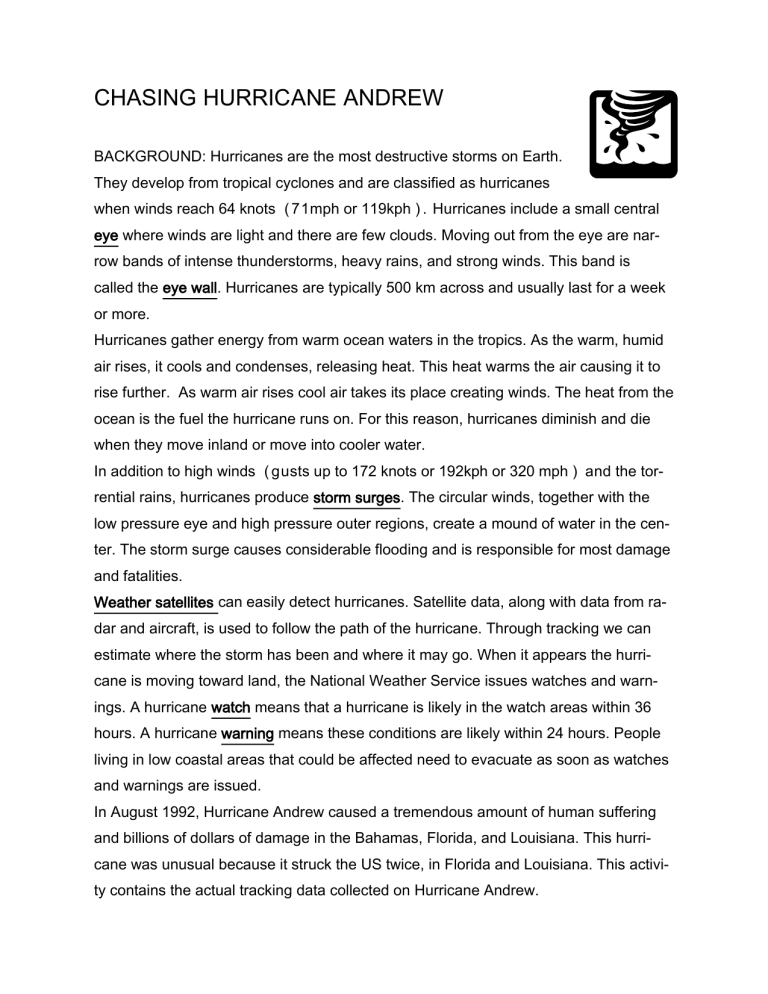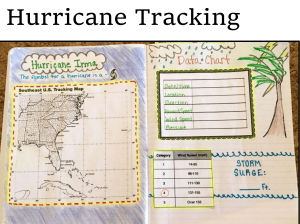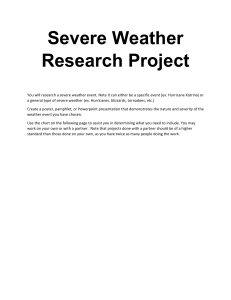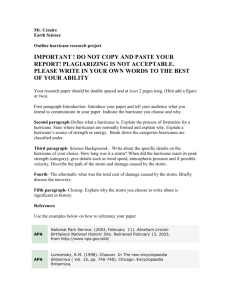
CHASING HURRICANE ANDREW BACKGROUND: Hurricanes are the most destructive storms on Earth. They develop from tropical cyclones and are classified as hurricanes when winds reach 64 knots ( 71mph or 119kph ) . Hurricanes include a small central eye where winds are light and there are few clouds. Moving out from the eye are narrow bands of intense thunderstorms, heavy rains, and strong winds. This band is called the eye wall. Hurricanes are typically 500 km across and usually last for a week or more. Hurricanes gather energy from warm ocean waters in the tropics. As the warm, humid air rises, it cools and condenses, releasing heat. This heat warms the air causing it to rise further. As warm air rises cool air takes its place creating winds. The heat from the ocean is the fuel the hurricane runs on. For this reason, hurricanes diminish and die when they move inland or move into cooler water. In addition to high winds ( gusts up to 172 knots or 192kph or 320 mph ) and the torrential rains, hurricanes produce storm surges. The circular winds, together with the low pressure eye and high pressure outer regions, create a mound of water in the center. The storm surge causes considerable flooding and is responsible for most damage and fatalities. Weather satellites can easily detect hurricanes. Satellite data, along with data from radar and aircraft, is used to follow the path of the hurricane. Through tracking we can estimate where the storm has been and where it may go. When it appears the hurricane is moving toward land, the National Weather Service issues watches and warnings. A hurricane watch means that a hurricane is likely in the watch areas within 36 hours. A hurricane warning means these conditions are likely within 24 hours. People living in low coastal areas that could be affected need to evacuate as soon as watches and warnings are issued. In August 1992, Hurricane Andrew caused a tremendous amount of human suffering and billions of dollars of damage in the Bahamas, Florida, and Louisiana. This hurricane was unusual because it struck the US twice, in Florida and Louisiana. This activity contains the actual tracking data collected on Hurricane Andrew. PROCEDURE 1. Review the data table. It contains three types of information: A. Date/Time: Data was collected every six hours from 8/16 through 8/28. Time is given in military convention; for example, 1200 is noon and 1800 is 6pm. B. Position: This is the position of the eye using latitude and longitude. It is important to remember that the storm is much bigger than the eye. The wind extend out beyond the eye about 100km in all directions ( a bout one half the area of one 5degree longitude-latitude square on the map ) C. Wind speed : This is the maximum speed of winds not the speed with which the hurricane is moving. Wind speed is given in knots. 1 knot = 1.15mph=1.85kph. 2. Plot the data on the map. Make a dot for each position and then connect the dots. For each position at the beginning of the day, ( time = 0000 ) draw a small star over the dot. 3. You will be asked to stop periodically and issue warnings and watches based on the path of the hurricane. HURRICAN ANDREW TRACKING DATE/TIME LATITUDE °N LONGITUDE °W WIND SPEED ( K NOTS ) 8/21 8/22 8/23 0000* 23.2 62.4 45 0600 23.9 63.3 45 1200 24.4 64.2 50 1800 24.8 64.9 50 0000* 25.3 65.9 55 0600 25.6 67 60 1200 25.8 68.3 70 1800 25.7 69.7 80 0000* 25.6 71.1 90 STOP: # 1. BASED ON HOW FAR THE STORM HAS TRAVELED IN THE LAST 24 HOURS AND ITS DIRECTION, FOR WHICH LOCATIONS WOULD YOU ISSUE WARNINGS AND WATCHES? YOU CAN TELL BY LOOKING AT THE DISTANCE BETWEEN THE LAST TWO STARS YOU HAVE DRAWN ON THE MAP. DON ’ T FORGET THE SIZE OF THE HURRICANE IS MUCH LARGER THATN THE DOTS YOU HAVE DRAWN. DATE/TIME LATITUDE °N LONGITUDE °W WIND SPEED ( K NOTS ) 8/23 8/24 0600 25.5 72.5 105 1200 25.4 74.2 120 1800 25.5 75.8 135 0000* 25.4 77.5 125 STOP #2: BASED ON HOW FAR THE STORM HAS TRAVELED OVER THE LAST 24 HOURS AND ITS DIRECTION SO FAR FOR WHICH LOCATIONS WOULD YOU ISSUE WARNINGS AND WATCHES? DATE/TIME LATITUDE °N LONGITUDE °W WIND SPEED ( K NOTS ) 8/24 8/25 0600 25.4 79.3 120 1200 25.6 81.2 110 1800 25.8 83.1 115 0000* 26.2 85.0 115 STOP #3: BASED ON HOW FAR THE STORM HAS TRAVELED OVER THE LAST 24 HOURS AND ITS DIRECTION SO FAR FOR WHICH LOCATIONS WOULD YOU ISSUE WARNINGS AND WATCHES? DATE/TIME LATITUDE °N LONGITUDE °W WIND SPEED ( K NOTS ) 8/25 8/26 0600 26.6 86.7 115 1200 27.2 88.2 115 1800 27.8 89.6 120 0000 * 28.5 90.5 120 STOP #4 BASED ON HOW FAR THE STORM HAS TRAVELED OVER THE LAST 24 HOURS AND ITS DIRECTION SO FAR FOR WHICH LOCATIONS WOULD YOU ISSUE WARNINGS AND WATCHES? DATE/TIME LATITUDE °N LONGITUDE °W WIND SPEED ( K NOTS ) 8/26 8/27 0600 29.2 91.3 115 1200 30.1 91.7 80 1800 30.9 91.6 50 0000* 31.5 91.1 35 STOP #5 BASED ON HOW FAR THE STORM HAS TRAVELED OVER THE LAST 24 HOURS AND ITS DIRECTION SO FAR FOR WHICH LOCATIONS WOULD YOU ISSUE WARNINGS AND WATCHES? Name: _ _ _ _ _ _ _ _ _ _ _ _ HURRICANE ANDREW WARNINGS AND WATCHES 1. WARNING: _ _ _ _ _ _ _ _ _ _ _ _ _ _ _ _ _ _ _ _ _ _ _ _ _ _ _ _ WATCH: _ _ _ _ _ _ _ _ _ _ _ _ _ _ _ _ _ _ _ _ _ _ _ _ _ _ _ _ _ _ 2. WARNING: _ _ _ _ _ _ _ _ _ _ _ _ _ _ _ _ _ _ _ _ _ _ _ _ _ _ _ _ WATCH: _ _ _ _ _ _ _ _ _ _ _ _ _ _ _ _ _ _ _ _ _ _ _ _ _ _ _ _ _ _ 3. WARNING: _ _ _ _ _ _ _ _ _ _ _ _ _ _ _ _ _ _ _ _ _ _ _ _ _ _ _ _ WATCH: _ _ _ _ _ _ _ _ _ _ _ _ _ _ _ _ _ _ _ _ _ _ _ _ _ _ _ _ _ _ 4.WARNING: _ _ _ _ _ _ _ _ _ _ _ _ _ _ _ _ _ _ _ _ _ _ _ _ _ _ _ _ WATCH: _ _ _ _ _ _ _ _ _ _ _ _ _ _ _ _ _ _ _ _ _ _ _ _ _ _ _ _ _ _ 5.WARNING: _ _ _ _ _ _ _ _ _ _ _ _ _ _ _ _ _ _ _ _ _ _ _ _ _ _ _ _ WATCH: _ _ _ _ _ _ _ _ _ _ _ _ _ _ _ _ _ _ _ _ _ _ _ _ _ _ _ _ _ _ Name: _ _ _ _ _ _ _ _ _ _ _ _ _ _ _ _ HURRICANE ANDREW QUESTIONS AND CONCLUSIONS 1. Why is the eye wall dangerous? _ _ _ _ _ _ _ _ _ _ _ _ _ _ _ _ _ _ _ _ _ _ _ _ _ _ _ _ _ _ _ _ _ _ _ _ _ _ _ _ _ _ _ _ _ _ _ _ _ _ _ _ _ _ _ _ _ _ _ _ _ _ _ _ _ 2. List the dangers associated with storm surges. _ _ _ _ _ _ _ _ _ _ _ _ _ _ _ _ _ _ _ _ _ _ _ _ _ _ _ _ _ _ _ _ _ _ _ _ _ _ _ _ _ _ _ _ _ _ _ _ _ _ _ _ _ _ _ _ _ _ 3. How are hurricanes tracked? _ _ _ _ _ _ _ _ _ _ _ _ _ _ _ _ _ _ _ _ _ _ _ _ _ _ _ _ _ _ _ _ _ _ _ _ _ _ _ _ _ _ _ _ _ _ _ _ _ _ _ _ _ _ _ _ _ _ _ _ _ _ _ _ _ _ 4. What is the difference between a warning and a watch? _ _ _ _ _ _ _ _ _ _ _ _ _ _ _ _ _ _ _ _ _ _ _ _ _ _ _ _ _ _ _ _ _ _ _ _ _ _ _ _ _ _ _ _ _ _ _ _ _ _ _ _ _ _ 5. Where did the hurricane do the most damage before striking Florida? _ _ _ _ _ _ _ _ _ _ _ _ _ _ _ _ _ _ _ _ _ _ _ _ _ _ _ _ _ _ _ _ _ _ _ _ _ _ _ _ 6. Describe the motion of the storm from beginning to end. _ _ _ _ _ _ _ _ _ _ _ _ _ _ _ _ _ _ _ _ _ _ _ _ _ _ _ _ _ _ _ _ _ _ _ _ _ _ _ _ _ _ _ _ _ _ _ _ _ _ _ _ _ 7. What happened to the direction of Andrew after it came aground in Louisiana? Why did this happen? _ _ _ _ _ _ _ _ _ _ _ _ _ _ _ _ _ _ _ _ _ _ _ _ _ _ _ _ _ _ _ _ _ _ _ _ _ _ _ _ _ _ _ _ _ _ _ _ _ _ _ _ _ _ _ _ _ _ _ _ _ _ _ _ _ _ _ _ _ _ _ _ _ Name: _ _ _ _ _ _ _ _ _ _ _ _ _ _ _ _ _ _ 8. Give the day and time that Andrew became a hurricane: _ _ _ _ _ _ _ _ _ _ _ _ _ Give the day and time that it should have been downgraded to a tropical storm: _ _ _ _ _ _ _ _ _ _ _ _ _ _ _ _ _ _. 9. Why did Hurricane Andrew do so much damage to the southern part of Florida? _ _ _ _ _ _ _ _ _ _ _ _ _ _ _ _ _ _ _ _ _ _ _ _ _ _ _ _ _ _ _ _ _ _ _ _ _ _ _ _ _ _ _ _ _ _ _ _ _ _ _ _ _ _ _ _ _ _ _ _ _ _ _ _ _ _ _ _ _ _ _ _ _ _ _ _ _ _ _ _ _ _ 10. If Hurricane Andrew had traveled up the coast to South Carolina why might it have been less destructive? _ _ _ _ _ _ _ _ _ _ _ _ _ _ _ _ _ _ _ _ _ _ _ _ _ _ _ _ _ _ _ _ _ _ _ _ _ _ _ _ _ _ _ _ _ _ _ _ _ _ _ _ _ _ _ _ _ _ _ _ _ _ _ _ _ _ _ _ _ 11. Meteorologists have to be careful about issuing warnings and watches. Why? _ _ _ _ _ _ _ _ _ _ _ _ _ _ _ _ _ _ _ _ _ _ _ _ _ _ _ _ _ _ _ _ _ _ _ _ _ _ _ _ _ _ _ _ _ _ _ _ _ _ _ _ _ _ _ _ _ _ _ _ _ _ _ _ _ _ _ _ _ _ _ _ _ _ _ _ _ _ _ _ _ 12. If you lived in a coastal area that was prone to hurricanes, what precautions would you take? _ _ _ _ _ _ _ _ _ _ _ _ _ _ _ _ _ _ _ _ _ _ _ _ _ _ _ _ _ _ _ _ _ _ _ _ _ _ _ _ _ _ _ _ _ _ _ _ _ _ _ _ _ _ _ _ _ _ _ _ _ _ _ _ _ _ _ _ _ _ _ _ _ _ _ _ _ _ _ _ _ _ _ _ _ _ _ _ _ _ _ _ _ _ _ _ _ _ _ _ _ _ _ _ _ _ _ _ _ _ _ _ _ _ _ _ _ _ _ _ _ _





